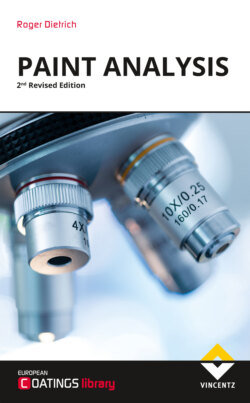Читать книгу Paint Analysis - Roger Dietrich - Страница 25
На сайте Литреса книга снята с продажи.
2.8Implementation
ОглавлениеDespite all the potential that instrumental analysis methods have for supporting production processes, it is often not possible to implement this concentrated knowledge in the process. This leads to the frustration of the person commissioning the analyses and to the understandable reaction to reject these procedures. But what is the reason for this? The essential factor that contributes to the success of a problem solution with the help of analytical procedures is the flow of information between laboratory and client on the one hand and within the structures of the client on the other. An example:
Figure II.6: Optical light microscope image of a coating surface with a deposit
A coating did not pass a climate test, because it developed a deposit on the surface (Figure II.6). The paint shop manager orders a laboratory to investigate this phenomenon. To be more precise, the laboratory is commissioned to investigate the composition of the deposit. Through analysis with TOF-SIMS and the ATR-FT-IR method (Figure II.7), the laboratory determines the composition of the deposit and communicates: The coating consists of 2-[4-[2-hydroxy-3-tridecyloxypropyl]oxy]-2-hydroxyphenyl-4,6-bis(2,4-dimethylphenyl)-1,3,5-triazine.
Figure II.7: Results of the analysis of the deposit by a) ATR-FT-IR and b) TOF-SIMS
At this point, the non-chemically trained client might put a large question mark: “How does this help me now?” This result can only help, if there is a suitable translator who can put the chemical formula, which is the result of the analysis, into a context with the production in order to answer the actual questions:
What happened in the climatic test?
Why did it happen?
What do we learn from this for prevention?
It is therefore necessary at this point to have the knowledge of in-house experts or of the experts in the commissioned laboratory, who can translate the result into knowledge of the products used in the company. This translator has a decisive role to play and at the same time this task requires many complex processes.
First of all, this includes knowing what technical substance, raw material etc. is involved. In this specific case, the knowledge that the identified compound is a UV stabilizer with the trade name “Tinuvin” 400.
The next step is to check with the coating development laboratory whether this UV stabilizer is actually a formulation component of the coating. This requires the knowledge of the coating developer or, if this is not available or not accessible, a further laboratory analysis on a reference sample of the coating material. If the result of this research or subsequent analysis is: yes, “Tinuvin” 400 is a formulation component, then it is already certain: The climatic test enriches the coating additive on the surface. So, once it is clear what happened, the search for possible causes can begin. Here, the knowledge of the paint specialist or developer is needed to check overdosing, incorrect choice of stabilizer, interaction with other additives, etc.
If the evaluation of the research shows: no, “Tinuvin” 400 is not a component of the formulation, however, completely different questions arise regarding errors in the paint production, cross-contamination due to faulty test procedures, etc.
This means that the original analysis result, the chemical identification of the substance on the surface, requires a number of evaluation processes, for which well-trained specialists are needed, who have knowledge of the processes and the materials used and can manage the transfer from the analysis result to process improvement. This means that the technical processes presented in the previous chapters can help to better understand a problem and to uncover errors or false assumptions.
